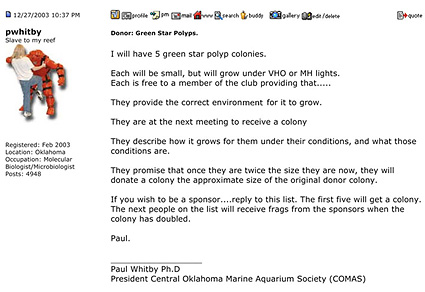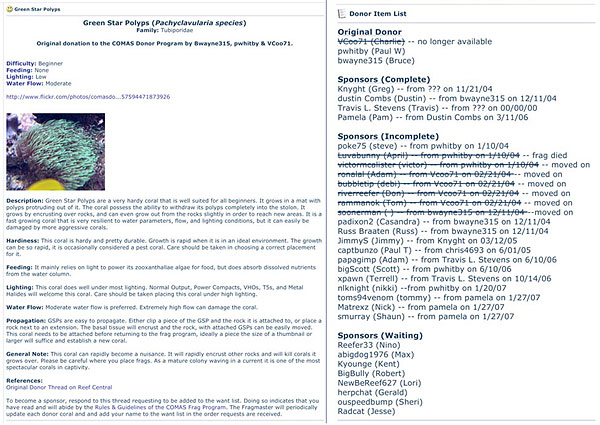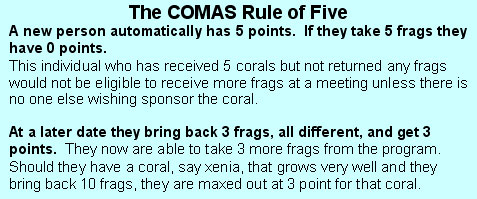|
The COMAS Coral Donor Program
by Paul W. Whitby Ph.D, President of the Central Oklahoma Marine Aquarium Society
As a President of a marine aquarium club, I have two main responsibilities, the first is to help our club retain members and encourage new memberships while the second is to develop programs that provide an educational and/or practical benefit to the members. I wish to share with you one of the programs that we have developed inside the Central Oklahoma Marine Aquarium Society (COMAS) that has had an extremely positive impact on memberships, has provided a subject for numerous educational events and has a positive conservation aspect. This program, the Donor Program, has evolved a great deal since its inception in 2003, in both scope and format, and has become one of the key programs inside COMAS. My purpose in writing this article is to provide the logistical framework to allow other clubs to develop a similar program and discuss the challenges we have encountered along the way.
Overview
The basic premise of the donor program relies on the fact that many of us will have a coral that does exceptionally well inside our system and multiplies rapidly, or at least sufficiently well to make frags of. These corals form the basis of the Donor Program. The concept is that these coral would do equally well in the tanks of other members of the club, so long as they provide it with the optimal growth conditions required by that coral. The owner of the coral, being familiar with it and how it grows, brings suitable frags to a meeting where they are distributed to other people interested in propagating it. These people then take the newly acquired frag and nurture it, as described by the owner, to ensure it grows. Once the coral has reached a sufficient size such that it can be split, without damage to the colony or the resulting frag, it is divided and the new frag returned to the club for distribution to the next person. This is repeated at a later date so that each person returns at least two frags of each coral they receive. A person bringing the first frag is noted as the Original Donor while people receiving frags are referred to as Sponsors.
History of the COMAS Coral Donor program
The Donor Program was established on December 27 2003. At that time, I offered several frags of green star polyps to members of the club. A thread was opened in ReefCentral as shown below. The thread contained the simple elements of the program. These were: 1) That the sponsor provide the correct environment for it to grow. 2) That they are present at the next meeting to receive a frag. 3) That they describe their tank conditions and how well the coral grows for them under those conditions. Most importantly it states that, “Once the coral has doubled its size in growth, the sponsor promises to return to the donor program a new frag of the approximate size of the frag they received.” With that simple post the program had begun. Since then, we have added a further 60 corals as well as several classes of mobile invertebrates (such as micro brittle stars and colonista snails). Over the last three years we have passed out approximately 85 original donor frags and have received back for further distribution in excess of 600 frags. Many corals are on their fourth generation and several are approaching fifth generation.
The following three sections detail our experience of this program. They each represent an increasing level of direct club management in the program as well as increasing levels of technology. Each of these stages was brought about as a direct result of the growth and evolution of the program. Smaller clubs are ideally suited to the set up we utilized in the early years, but knowledge of the downstream problems will help you tailor this program to avoid these pitfalls.
 |
Screen shot from the original donor thread on Reef Central -
Link |
Development of The Donor Program: The Early Years
Initially the donor program was simple to track. We realized from the beginning that it was important to have a sign up list for each frag. We simply utilized the available resources of ReefCentral and used a single thread for each individual coral inside our club forum. We asked that each new thread began with the word “DONOR” to allow members to search the forum for the threads. As new people wanted to be added the waiting list they simply copied the “have/want” list and added their name as appropriate. When a person had received a coral, we relied on them to update the list by copying and pasting and moving their name from “want” to “have”. This worked really well for several years. However as the number of different donor corals increased towards 40, problems began to arise. I include these for anyone wishing to institute this program as potential pitfalls. Firstly, we noticed that people would offer a new coral up for the program without checking if we already had that coral listed. We had, at one point, 3 separate threads for green star polyps and several for cabbage leathers. People would leave out the word DONOR from the thread title and the thread would rapidly become lost in our busy forum. Several times people would start a thread for two corals at once. This latter situation was incredibly difficult to resolve. We also experienced people establishing a thread and not showing up to pass along the original donor corals, as well losing corals from the program due to death. To overcome these issues, we instituted a Donor Program Director (DPD) in 2005 in an attempt to bring order back to what was becoming chaotic.
The Donor program: The Intermediate Years
With the institution of the DPD the donor program returned to steady state. The first task the DPD performed was to request that all frags brought to a meeting be passed to them for distribution to the waiting sponsors. This allowed the DPD to more accurately record who was returning, as well as, who was receiving frags. Next, they created a master list of all threads and added it as a sticky at the top of the RC forum for our club. This enabled rapid and easy searching of all the corals listed and facilitated the updating of existing corals and the introduction of new donor corals. The DPD consolidated threads that shared a common donor coral and attempted to ascertain the status of corals that had not been returned by a sponsor for a long period of time. One of the things that became immediately apparent was the necessity to be able to establish a timeline of when corals were passed from sponsor to sponsor. With this, the DPD could reasonably assess when a coral would be ready for fragging and politely remind individuals of their responsibility. The net result was a much more focused program with increased success as measured by the frag return rates. This, however, did not come without its own price tag. Toward the middle of 2006, we had a growing membership base, all of who were interested in acquiring frags from this program. Often, a person would sign up for multiple corals causing 40 threads, all at once, to be bumped to the top of our RC forum. This happened on an almost weekly basis and became frustrating to the existing members. Thus, began the migration of the donor program to a new format and venue.
 |
First two posts of a donor thread on COMAS website. Notice the standard format for corals passed on, died or growing as well as people waiting. -
Link |
The Donor Program: The COMAS Years
Early 2007, we established a vbulletin based forum to house the donor program. During the migration we instituted a number of final changes that we hope will make this program even more successful. For example, we developed a standard template for each coral thread. This was done to allow several very important features. These will be described in more detail below:
- At the top of each thread we included difficulty level as well as light/feeding/water flow requirements to allow a new sponsor to gauge their chances of propagating this coral.
- We included a picture of the actual coral in the owner’s tank (when possible) as well more general information on how to grow and propagate that coral.
- Finally we asked that sponsors be aware of their obligations to return propagated frags.
The next post contained the “Have” and the “Want” list. In setting these up, we decided to use a standard notation throughout that would allow simple script based searches to develop statistics that could be implemented to determine the number of frags out at any time, who had which corals, which corals had died, etc. All of this can be seen in Figure 2. Finally, anyone wishing to be added simply has to reply to the post and request to be added, or they may supply other information such as death of the frag. The DPD, having moderator rights, would then update the second post and delete the sponsors post, keeping each thread clean and tidy. We also ask sponsors to post their experiences with the coral, how it grows for them, before and after growth pictures, etc. All of the supplied information can be compiled as an educational asset for each coral.
Having our own dedicated forum for this program has also allowed us to build index threads. These are essentially lists of all corals grouped by difficulty level, water/light or feeding requirements. This functionality makes it extremely easy for a user to find corals suited to their tank.
The Donor Program: Educational Spin-Offs
The donor program has generated a great deal of enthusiasm and we have utilized it as a basis for a number of educational events inside the club. Using corals donated to COMAS by various vendors, or purchased with club funds, we have held “hands on” fragging demonstrations. These have been instrumental in teaching people easy ways to propagate their corals and overcome the inherent fear of causing damage or possible death to a coral specimen. At the end of the demonstration we held a drawing for the newly fragmented corals, and each recipient is automatically enrolled as a sponsor of that coral. We have also included guidelines on how to frag corals as well as ideal sizes of frags to be passed around. This latter point was instituted when we realized many frags were dying due to not being mounted and blowing away in the tank current (mushrooms and zoanthids) or being too small a piece to survive (particularly leather corals). We have also included a number of fragging demonstrations on our website that are linked to from each thread and have asked our members to submit articles related to fragmenting corals.
And Finally...
With a club having 200+ members, we feel that it is important that all have equal opportunity to receive and grow corals from this program. While this is not a real issue with a smaller club, we have had to institute a “rule of five”. We determined this would be the best way to add both an element of accountability for the frags being passed around, and ensure that frags pass through the DPD and are recorded in the forum. The rule works by giving each member 5 frag points. Every frag taken from the donor program removes 1 frag point. Every new “original donor frag” adds a frag point. For every sponsored coral frag that is returned in good condition (according to the posted specifications) another point is awarded (up to a maximum of 3 points per sponsored coral).
 |
If a participant is highly active in donating or returning sponsored corals to the system, they can have a nearly unlimited number of sponsored frags. If a member repeatedly kills corals, it allows the DPD to recognize this fact and then offer help to get the tank parameters in order, again adding an educational aspect to the program. Tracking all of this information is made easy by the standardization of each thread. Exceptions to the rule of five do occur, for example when no one else wants the frag available except a person who has maxed out the 5 points. They then receive it and the points are adjusted accordingly. We have found this to be a very fair way to pass corals and ensures a diverse brood stock for other members.
A testament to how successful this program has become is the fact that at a recent meeting we received and dispersed in excess of 100 frags to members. I hope that by sharing the development of our program you may be encouraged to begin your own. The benefit to the club is enormous and is almost guaranteed to bring new members, if only for the free frags.
Acknowledgements
This program would have been impossible to implement without the generosity of ReefCentral allowing local clubs to host their forums online. This is an invaluable tool for smaller clubs who may not be able to afford their own websites and forums. Without ReefCentral, COMAS would not have grown and prospered as it has over the last eight years. I also would like to thank all the people who have spent a great deal of time working on this program. In no particular order I want to thank Travis L. Stevens, Paul Thompson (CaptBunzo), and Timothy Vanwagoner (TimV).
Useful Resources:
The COMAS Community Coral Donor Forums
If you have any questions about this article, please visit my
author forum
on Reef Central.
|

